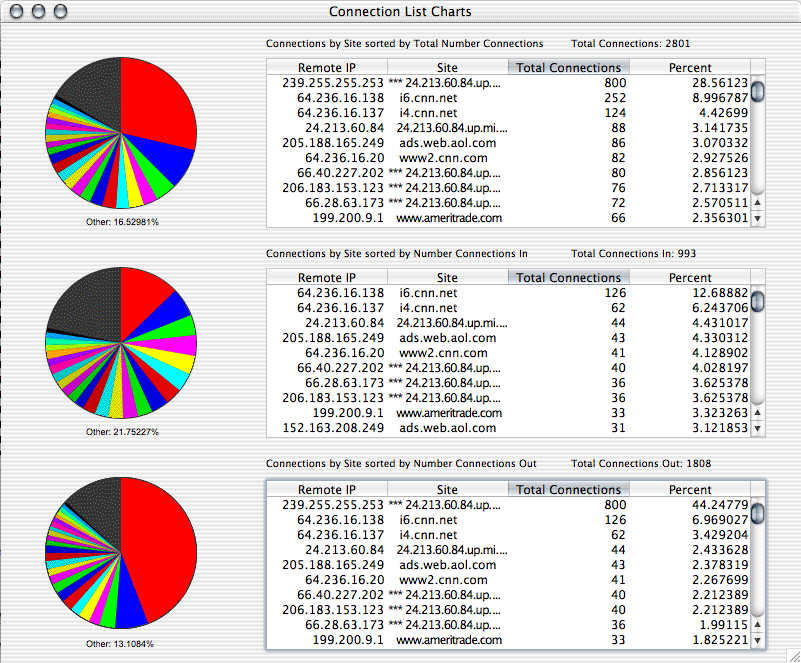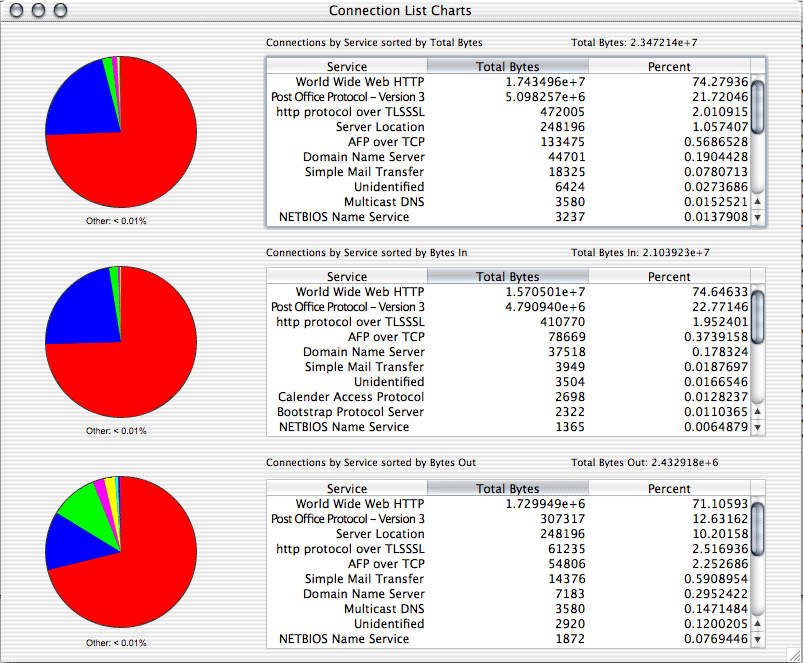 |
|
Application Note 1009Using the IPNetSentry Bandwidth Analyzer (IBA) as a Connection and Bandwidth Usage Analysis Tool
|
Scenarios 1. You wonder which service (HTTP, POP3, etc) uses the most bandwidth with your Internet connection. 2. You would like to see a graphical display of which sites (remote IP addresses) are most heavily accessed. Step 1: Acquire Data We first need to acquire connection log data using IPNetSentryX. To do this open the IPNetSentryX Preferences window and:
Once this setting has been made, let IPNetSentryX acquire a few hours worth of data. You can be using the machine at the time or just let it sit idle (but it should not go to sleep). Step 2: Analyze the Data Open one of your "Connection Log" files. This data will be displayed in a slightly different format than the Bandwidth Log file:
From the popup menus in the lower right hand side of the window you can determine how you want the data summarized. There are four principal summaries available: Connections by Site sorted by Total Bytes Connections by Site sorted by Number of Connections Connections by Service sorted by Total Bytes Connections by Service sorted by Number of Connections In addtion to these four principal summaries, each summary plotsTotal Bytes (or Connections), Bytes In (or Connections In) and Bytes Out (or Connections Out). For example, here is a plot of Connections by Site sorted by Total Bytes:
The pie charts display the top 25 items in each list (in this case, representing the top 25 sites visited). If we view the same data based on number of connections (instead of bytes) we get:
What we see here is that our Mac OS X system is issuing many more small datagrams for the "Server Location" service than any other service. These datagrams are sent to IP address 239.255.255.253. Looking at the data itself, we can see that these datagrams are only 320 bytes in length. Should we be concerned? Not in this case, since the datagrams are small enough not to interfere with the normal upstream behavior of our network connection. One group of connections worth watching are the connections to "ads.web.aol.com". These are banner graphics which are loaded when we connect to the CNN web site. These connections comprise 5% of our outgoing bandwidth (based on bytes), and almost 2.5% of our outgoing connections. Depending upon the traffic at the "ads.web.aol.com" we may experience some unnecessary delay, and hence may wish to block the receipt of such ads with IPNetSentryX. Looking at the same data based on services and bytes used for each service we see:
Not surprising, almost 75% of our bandwidth is used for HTTP type connections and 22% is used for POP3 email connections. When viewed by number of connections we see:
Again, the number of web server (HTTP) connections is the leader, but this is closely followed by the number of Server Location connections. There is one additional feature which can be used to adjust the data being plotted. This is the "Exclude DNS" checkbox in the Connection List window. The reason for this is that in the process of doing remote IP address lookups, the IBA will make connections to your ISP's default name server in order to perform the reverse name lookups. As you might expect, the number of such connections could be substantial, and hence skew the results being plotted. For this reason you may want to exclude Domain Name Server (DNS) connections from being included in the plots. Conclusion Bandwidth usage analysis was once the domain of large corporate network administrators. With the popularity of broadband connections, it can be beneficial for each of us to occasionally perform our own bandwidth usage and connection analysis. Not only do such analyses point out what services we most often use and remote sites we visit, but subsequent actions might also help increase the overall performance of our network connections. The IPNetSentryX Bandwidth Analyzer is one tool which will signficantly aid the lay person in performing bandwidth analysis. Please send questions, comments, or suggestions using our general
requests form: |
|
 Privacy
Policy
Privacy
Policy  Contact
Us
Contact
Us




